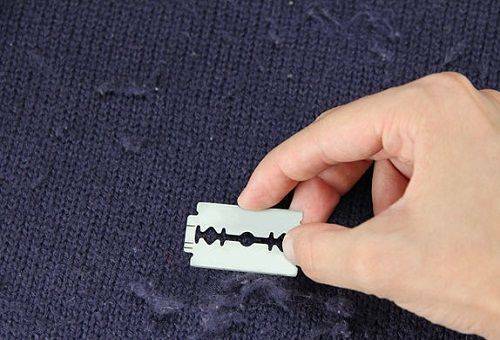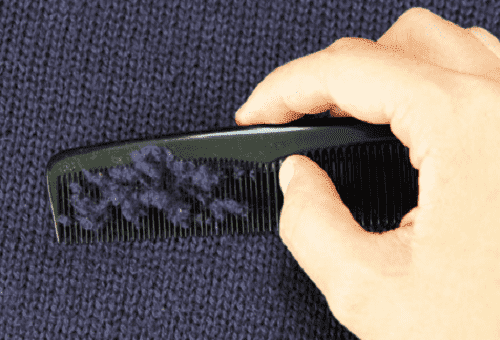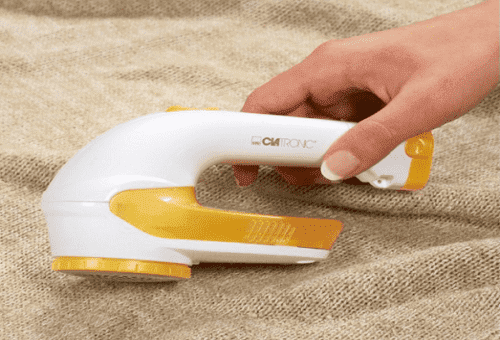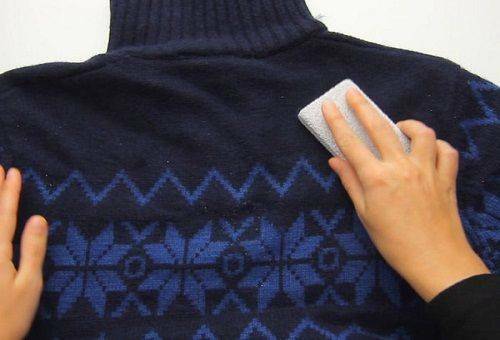The appearance of the rolled fibers on the surface of natural fabrics is inevitable with the regular wearing and washing of things. Very few people think about how to get rid of spools on clothes, preferring to just delete them manually as they arise. In fact, there are more effective, quick and practical solutions to the problem. They can all be used at home with regular care of the products and, if necessary, their emergency rescue immediately before leaving home.

Causes of formation of spools and prevention of an unpleasant phenomenon
Fibers of natural tissues, subject to constant friction, sooner or later begin to change, which leads to the formation of pellets. If this occurs soon after purchasing a sweater, sweater, or other garment, the reason may be the improper care of the product:
- Using a wash schedule that does not match the type of fabric. In this process, there are no secondary parameters. It is necessary to correctly set the duration of treatment, temperature, take into account the number of revolutions and additional data.
- Use of aggressive detergents. Today, manufacturers of household chemicals offer special drugs that prevent the fiber from rolling down.
- Inadequate effect on too loose fabrics. Densely twisted fibers are not so strongly subject to the problem of the formation of pellets. But the loose arrangement of threads can provoke the problem very quickly, therefore such things should be washed as little as possible, avoiding local dry cleaning.

Updating the wardrobe, you need to remember that the pellets rarely appear on items containing synthetic additives. For this reason, things with artificial fibers wear out much more slowly. You can confine yourself to mixed inserts only in problem areas: elbows, armpits, cuffs.
The most effective methods for removing spools from the surface of clothes
It is possible to quickly and qualitatively remove the spools from clothing only by machining the surface. At home, this can contribute to a lot of improvised tools. Some of them, at first glance, are absolutely unsuitable for this, but with proper operation they guarantee a good result.

- Pellet Remover If the wardrobe for a significant part consists of things sewn from natural materials, then it is best to buy a special machine for the removal of pellets. The best option will be a device with a knife height adjustment, which can remove all unnecessary even from products of the tender angora.
- Formations on small items can be removed with an old razor. Only act carefully, there is a high risk of damage to the product. We take the garment, stretch the problem zone and move the machine from the bottom to the top, making smooth and confident movements. This technique is not suitable for the treatment of long pile fabrics.
- If the pellets are very small, transparent tape will help. We cut off a piece, apply it to the problem zone, catch it and cut it off sharply. An additional plus of the approach is that, together with the formations, hairs, motes and threads are eliminated.
- Large single projections are best cut with manicure scissors. Pull off pieces of fiber can not, this can lead to damage to the product.

Tip: Immediately after processing the product with scissors, you need to walk on the surface with a soft brush for suede, which will restore the location of the villi. Otherwise, the areas from which the pile was cut are clearly visible on the fabric.
- Particles formed from a long nap are well removed with a scallop with small, frequent teeth. In this case, the main thing is not to stretch the material, moving carefully and thoroughly. The same effect is obtained by using an old toothbrush. If the product is fluffy, then you need to move in the course of the location of the villi. After processing, the thing can be washed to restore its fluffiness.
- On surfaces without pronounced pile, it is easiest to work with sandpaper with fine-grained relief. This option combines the principles of the action of the brush and razor, aligning the fabric and not stretching the strands.
- If you need not only to remove the pellets, but also to align the abrasions, you should use a breadcrumb of dense bread with small pores. Cut an impressive chunk, dry it in the sun or in the oven and use the type of brush. We operate carefully so as not to deform the material.
- If at hand there was nothing suitable than you could clean the clothes, you can do with a new sponge for washing dishes. The fabric should be driven by its dense side, however, this approach will not save you from large spools.

The signs of fabric wear are best removed at their early stages, and it is best not to allow them to form, carrying out preventive combing of the pile and providing them with appropriate care.
If the pellets need to be removed from a very delicate matter, it is better to turn to a dry cleaner, otherwise you can inevitably spoil the fabric. Experts not only gently and qualitatively clean the product, but also treat it with a special composition that prevents the formation of aesthetic defects.
